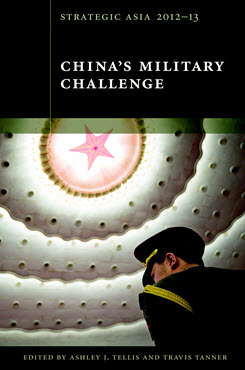The Second Artillery Force and the Future of Long-Range Precision Strike
This chapter evaluates China’s investment in long-range precision-strike capabilities and the impact on key areas of U.S. concern over the coming ten to fifteen years.
EXECUTIVE SUMMARY
This chapter evaluates China’s investment in long-range precision-strike capabilities and the impact on key areas of U.S. concern over the coming ten to fifteen years.
MAIN ARGUMENT
The People’s Liberation Army (PLA) relies on the Second Artillery Force for achieving strategic effects through direct targeting of enemy centers of gravity. The Second Artillery has a phased approach to fielding increasingly long-range conventional precision-strike systems that could have global reach by 2025. While the Second Artillery has not exercised a synchronized launch of more than a half dozen missiles, U.S. missile defenses would likely be unable to counter larger and more sophisticated Chinese missile raids. U.S. aircraft carriers and other ships could also be vulnerable. Addressing these challenges requires greater collaboration not only within the U.S. defense establishment but also between the U.S. and allies and partners in the region.
POLICY IMPLICATIONS
- Emerging PLA anti-access/area-denial capabilities could not only complicate the U.S. ability to operate in the Asia-Pacific region but also give the PLA a decisive edge in securing control over the skies around its periphery should territorial disputes erupt into conflict.
- A conventional global-strike capability would allow the PLA to reach targets deep inside the continental U.S. without relying on forward bases.
- The PLA’s growing capacity for long-range precision strike provides an incentive for China’s neighbors to shore up their defenses and develop similar strike capabilities, given that the most effective and efficient means of defending against China’s theater missiles would be neutralizing the missile infrastructure on the ground.
The emergence of the People’s Republic of China (PRC) as a major economic, technological, military, and political power is changing the dynamics within the Asia-Pacific region and the world at large. Efforts by the People’s Liberation Army (PLA) to acquire long-range precision-strike capabilities—ballistic missiles in particular—support the PRC’s quest for domestic and international political legitimacy, and help render the PLA a military that is commensurate with China’s rise as a major global power. The PLA is rapidly advancing its capacity to integrate sensors and long-range precision-strike assets in order to defend against perceived threats to national sovereignty and territorial integrity and thereby bolster the legitimacy of the Chinese Communist Party (CCP).
The Second Artillery Force is the PLA’s strategic missile force, tasked with achieving strategic effects through direct targeting of enemy centers of gravity. Previously, the Second Artillery’s mission was limited to deterrence and blunt instruments of mass destruction. However, since the fall of the Soviet Union in 1991, the Second Artillery has become central to PLA warfighting plans. Ballistic and extended-range cruise missiles are an attractive means of delivering lethal payloads due to the inherent difficulties in defending against them. Firepower delivered directly against critical nodes within an opponent’s operational system allows conventional air, naval, and ground operations to be carried out at reduced risk and cost. Control of the skies enables dominance on the surface below. With Second Artillery firepower support, PLA Air Force (PLAAF) and PLA Navy (PLAN) assets may gain and maintain the air superiority needed to coerce political concessions or achieve a decisive edge on the surface.
The Second Artillery’s conventional reach is gradually extending throughout the Asia-Pacific region as it expands its brigade infrastructure and introduces increasingly sophisticated missile systems. Its force modernization program encompasses the fielding of increasingly longer-range systems with improvements in accuracy and expanded infrastructure. At the same time, the Second Artillery is developing sophisticated warheads that could increase the destructiveness of China’s ballistic-missile force.
Ballistic missiles capable of delivering conventional payloads with precision have a coercive effect on neighbors with limited countermeasures. Use of force against Taiwan has been the principal illustrative planning scenario guiding PLA and Second Artillery force modernization. Enjoying the broadest support within the CCP Central Committee and Central Military Commission (CMC), the focus on a Taiwan scenario allows the PLA to modernize its forces without precipitating neighbors to invest significant additional resources into deterrents and defenses. Over time and with an industrial surge in missile production, the same coercive military capabilities focused on Taiwan could be directed against South Korea, Japan, the Philippines, Vietnam, Singapore, Australia, Thailand, India, and other countries in the region.
Emerging PLA anti-access/area-denial (A2/AD) capabilities may complicate the ability of the United States to operate in the region. Anti-access threats, designed to prevent an opposing force from entering an operational area, include long-range precision-strike systems that could be employed against bases and moving targets at sea, such as aircraft carrier battle groups. Area-denial involves shorter-range engagements and capabilities designed to complicate an opposing force’s freedom of action. Extended-range conventional precision-strike assets could suppress U.S. operations from forward bases in Japan, from U.S. aircraft carrier battle groups operating in the western Pacific, and perhaps—over the next five to ten years—from U.S. bases on Guam. The Second Artillery also appears to have developed and deployed an initial capability to strike moving targets at sea, such as aircraft carriers and destroyers.
A demonstrated ability to complicate U.S. operations within the region would reduce confidence in U.S. security assurances. Intended to counter lower-end threats, such as those of North Korea and Iran, U.S. missile defenses would likely be unable to counter larger and more sophisticated Chinese ballistic-missile raids. As a result, U.S. allies and ad hoc coalition partners…
Strategic Asia
The Strategic Asia annual edited volume incorporates assessments of economic, political, and military trends and focuses on the strategies that drive policy in the region. Learn more about Strategic Asia.


